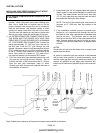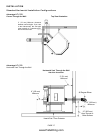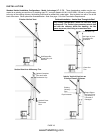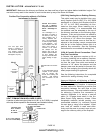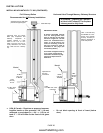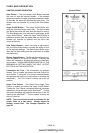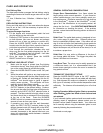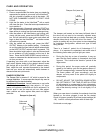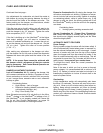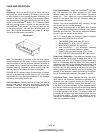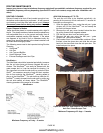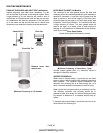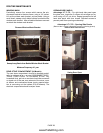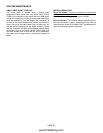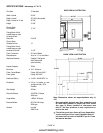CARE AND OPERATION
PAGE 24
Continued from last page…
Any adjustments for combustion air should be made at
the damper by varying the spacing between the side of
the stove and the inside of the damper set collar. The
factory setting on the damper, as noted above, should
correspond with the model you have.
If the fire goes out on the #1 setting, you will want to de-
crease the combustion airflow. Loosen the set collar and
push the damper in by 1/4” intervals. Tighten the collar
at its new position (2 1/2” – 2 3/4”).
If the fuel is building up in the UltraGrate
TM
at the higher
heat output settings, you will want to increase the
amount of available combustion air. Loosen the set col-
lar on the damper rod and pull the damper out. Do this
1/4” at a time. Tighten the collar at its new position
(1 3/4” – 2”).
After making any adjustment to the damper set collar,
pull the damper rod out fully and re-check the dimension
between the stove side panel and the inside of the set
collar.
NOTE: If the proper flame cannot be achieved with
the damper control, adjustment of the trim controls
may be necessary. See Control Board Operation on
Page 21 for information.
DAMPER ADJUSTMENT GUIDELINE
Lack of Combustion Air: By opening the damper, this
will increase combustion air delivery. Symptoms of insuf-
ficient combustion air include; unburned fuel, lazy smoky
or red / orange flame, excessive ash or soot, excessive
buildup on glass.
Contributing factors:
• High Altitude – Lack of oxygen
• Restrictive Venting (elbows, horizontal runs,
cold external chimneys, etc.).
• Dirty / Poor Quality Fuel.
Note: Excessive amounts of fly ash built-up in the Ultra-
Grate
TM
, clinkers in the UltraGrate
TM
or leakage of air (if
the UltraGrate
TM
is not properly seated) will starve the
fire for air. See Routine Maintenance, on pages 26
through 30 for information on cleaning the stove.
Excessive Combustion Air: By closing the damper, this
will reduce combustion air delivery. Symptoms of exces-
sive air include; fuel burns too quickly (results in smoking
or smoldering pellets), white to yellow flame, etc. If the
damper is open too much, the burning pellets will lift off
the UltraGrate
TM
and fly up into the air much like popping
corn does.
Contributing factor:
• Venting system providing excessive draft.
Correct Combustion Air / Proper Burn Characteris-
tics: When the damper is correctly set, the burning pel-
lets should move (wiggle) around slightly and the flame
should be bright yellow.
AUTOMATIC SAFETY FEATURES
Power Outage:
During a power outage, the stove will shut down safely. It
will not automatically restart when power is resumed un-
less the exhaust temperature is still hot enough. A small
amount of smoke may leak from the top of the window
glass, the hopper and from the exhaust air intake, if the
stove is vented horizontally with no vertical pipe. This will
not persist for more than 3 to 5 minutes and will not be a
safety hazard. It may set off your smoke alarm.
To re-light the stove, follow the normal procedure for
starting your stove.
Note: If the area in which you live is prone to frequent
power outages, it is recommended that a minimum of 8
feet (2 1/2 meters) of vertical vent pipe be included in a
freestanding installation to induce a natural draft in the
event of a power failure.
Overheating:
A high temperature switch will automatically shut down
the stove if it overheats. The stove will need to be manu-
ally re-lit. Allow up to 45 minutes cooling time before re-
lighting. Keep enough convection air (room air blower)
going through stove to keep it cooling properly, this will
ensure long life of the stove. If the overheating continues,
contact your authorized Lennox Hearth Products dealer
for more information.
www.PelletKing.com



